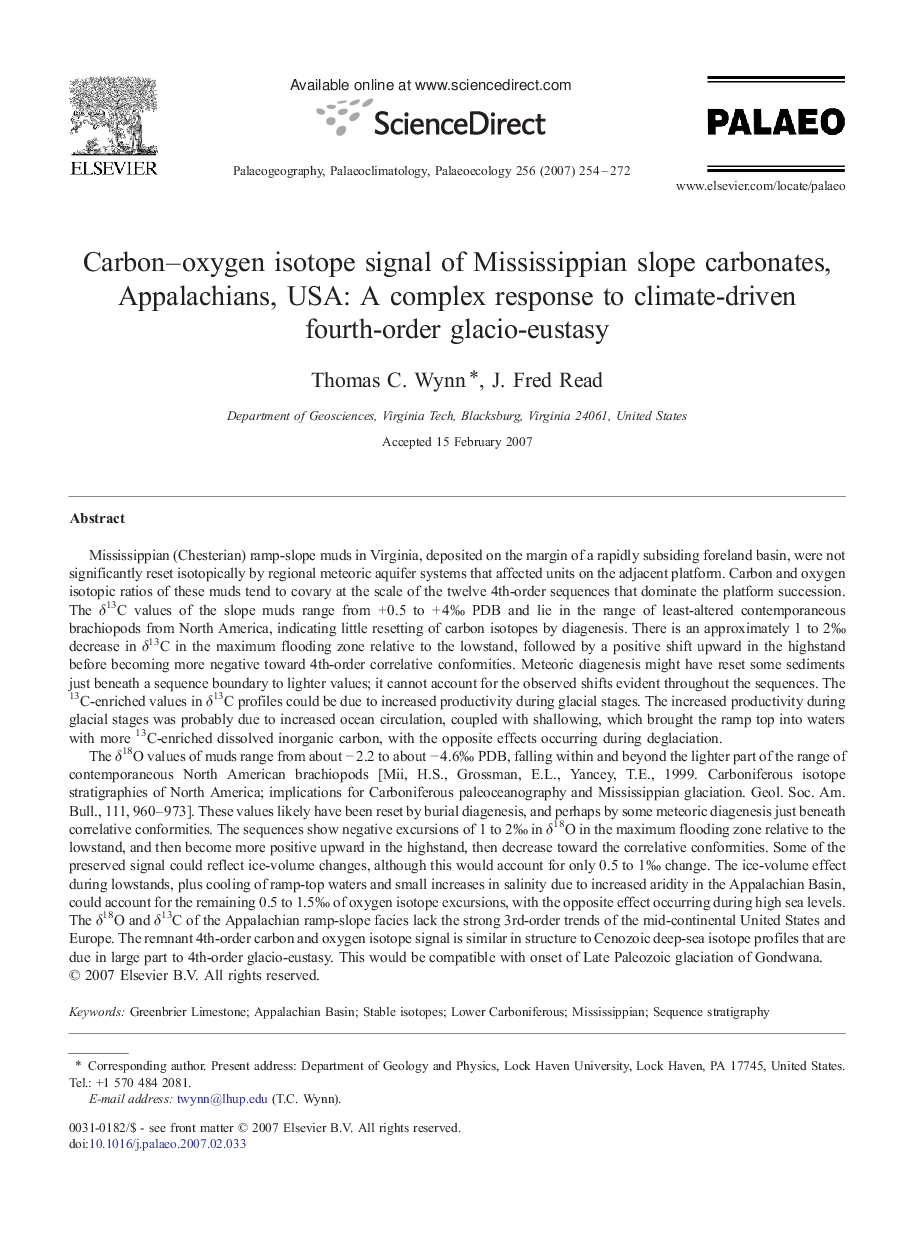| کد مقاله | کد نشریه | سال انتشار | مقاله انگلیسی | نسخه تمام متن |
|---|---|---|---|---|
| 4468801 | 1622338 | 2007 | 19 صفحه PDF | دانلود رایگان |

Mississippian (Chesterian) ramp-slope muds in Virginia, deposited on the margin of a rapidly subsiding foreland basin, were not significantly reset isotopically by regional meteoric aquifer systems that affected units on the adjacent platform. Carbon and oxygen isotopic ratios of these muds tend to covary at the scale of the twelve 4th-order sequences that dominate the platform succession. The δ13C values of the slope muds range from + 0.5 to + 4‰ PDB and lie in the range of least-altered contemporaneous brachiopods from North America, indicating little resetting of carbon isotopes by diagenesis. There is an approximately 1 to 2‰ decrease in δ13C in the maximum flooding zone relative to the lowstand, followed by a positive shift upward in the highstand before becoming more negative toward 4th-order correlative conformities. Meteoric diagenesis might have reset some sediments just beneath a sequence boundary to lighter values; it cannot account for the observed shifts evident throughout the sequences. The 13C-enriched values in δ13C profiles could be due to increased productivity during glacial stages. The increased productivity during glacial stages was probably due to increased ocean circulation, coupled with shallowing, which brought the ramp top into waters with more 13C-enriched dissolved inorganic carbon, with the opposite effects occurring during deglaciation.The δ18O values of muds range from about − 2.2 to about − 4.6‰ PDB, falling within and beyond the lighter part of the range of contemporaneous North American brachiopods [Mii, H.S., Grossman, E.L., Yancey, T.E., 1999. Carboniferous isotope stratigraphies of North America; implications for Carboniferous paleoceanography and Mississippian glaciation. Geol. Soc. Am. Bull., 111, 960–973]. These values likely have been reset by burial diagenesis, and perhaps by some meteoric diagenesis just beneath correlative conformities. The sequences show negative excursions of 1 to 2‰ in δ18O in the maximum flooding zone relative to the lowstand, and then become more positive upward in the highstand, then decrease toward the correlative conformities. Some of the preserved signal could reflect ice-volume changes, although this would account for only 0.5 to 1‰ change. The ice-volume effect during lowstands, plus cooling of ramp-top waters and small increases in salinity due to increased aridity in the Appalachian Basin, could account for the remaining 0.5 to 1.5‰ of oxygen isotope excursions, with the opposite effect occurring during high sea levels. The δ18O and δ13C of the Appalachian ramp-slope facies lack the strong 3rd-order trends of the mid-continental United States and Europe. The remnant 4th-order carbon and oxygen isotope signal is similar in structure to Cenozoic deep-sea isotope profiles that are due in large part to 4th-order glacio-eustasy. This would be compatible with onset of Late Paleozoic glaciation of Gondwana.
Journal: Palaeogeography, Palaeoclimatology, Palaeoecology - Volume 256, Issues 3–4, 6 December 2007, Pages 254–272